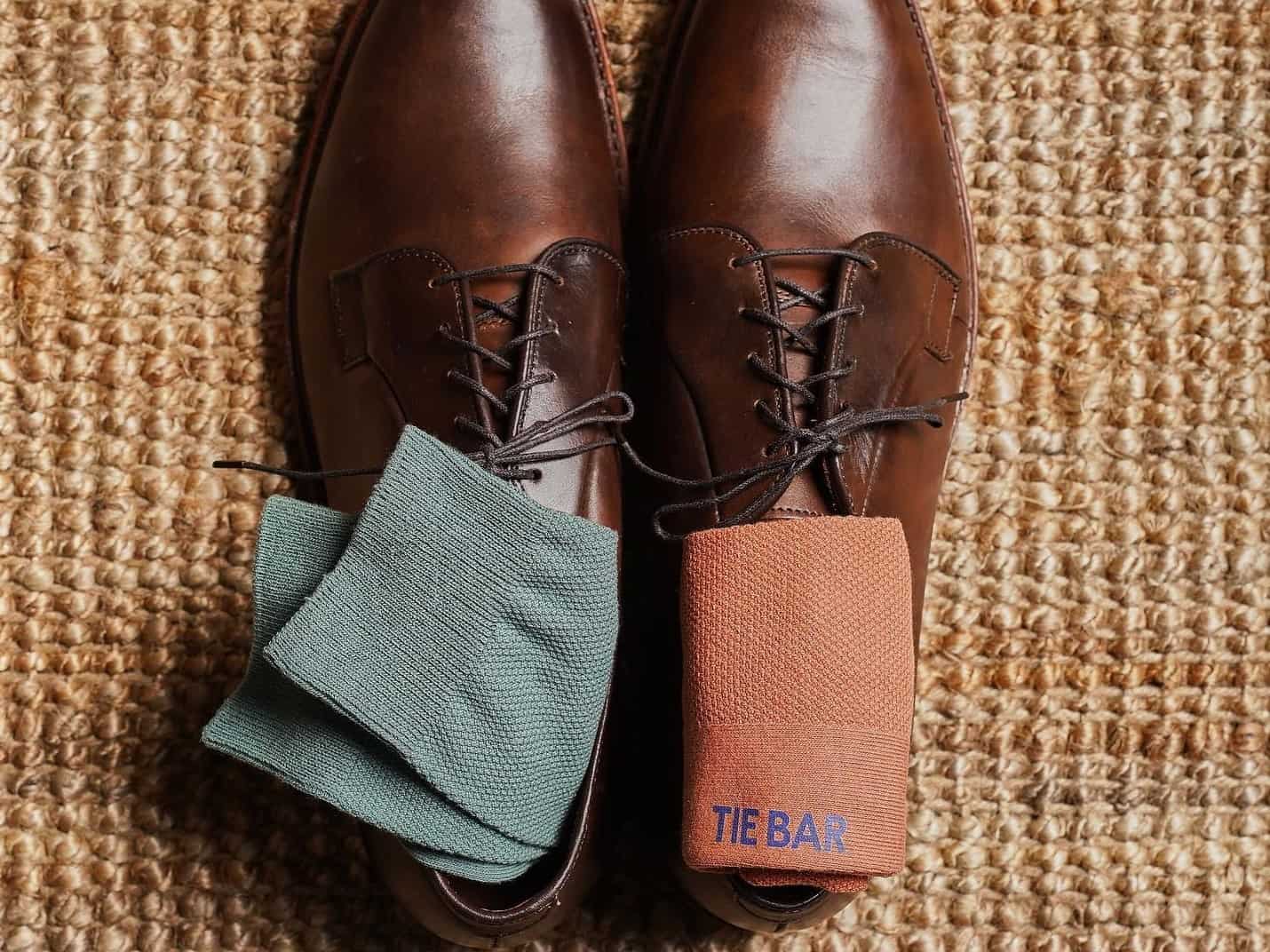When writing fashion-style pieces, one almost has to take a mindful approach to the subject of clothing. The things we don’t think twice about in everyday life, we fashion writers take a magnifying glass to and check in on.
For this article, we’re mindfully checking in on men’s socks styles and asking: what are the different types of socks for men? And when is each one appropriate?
Lengths, materials, and designs all change the way you will engage with said sock. And at the end of reading this article, you’ll be surprised (and, like me, possibly saddened) by how much you now know about types of socks for men. What’s the difference between a crew and a quarter? Or a compression sock and a liner sock? What’s the ideal fabric for workout socks? All types of men’s socks will be revealed.
There is great utility in this knowledge, and you can really impress your family this Christmas as you analyze and dissect their inevitable sock gift. But don’t just save it for your family.
You can also tell other uninterested men at dinner parties, bars, or even as you queue up to make your fast food order. But if you just want to lock away this information in the vault of your mind, that’s also fine. Without further epistemological contemplation, here is valuable information on the types of socks for men.
Key Takeaways
In the world of socks, generic men’s socks purchases (i.e., bulk ordering a load of the black ribbed crew or quarter socks) will actually get you very far. However, it’s crucial to consider the holes in your wardrobe (and socks).
Do you need dress socks for tailoring? Athletic socks? Or invisible socks for wearing sneakers in the summer? Get to know your types of socks for men now, and you won’t be left wanting in the future.

Of all the men’s socks styles, the “no show” sock is the most invisible. Not literally, just that they shouldn’t be visible when wearing sneakers or loafers. They are perfect if you want the sweat-soaking, rub-resistant, smell-beating comfort of a sock but don’t want them to get in the way of your outfit’s clean aesthetic.
A word of warning: if they fit well, they can be a great summer purchase. However, if your no-show socks slip down around your foot while on the move, you’ll know there are few things more irritating. They bunch up around your toes, causing pure strife. My advice? Get thick ones with strong elastic and shoot for a little padding on the rear to help with blistering and general comfort.

Still not showing, but they sit slightly higher up around the foot than the low version. The high no-show sock’s improved foot coverage means that slippage is less likely. The good thing about no-show socks in general is they let the design of the shoe flourish, not relying on a compliment from a sock, as it were. Best for boat shoes, loafers, moccasins, and sneakers.
It’s worth mentioning that they risk appearance on low loafers, such as a pair of G H Bass Weejuns, though this might be corrected by choosing the same color high now show sock as the loafer. It is dependent on the sock and the loaf.
P.S. In the nomenclature of types of men’s socks, all no-show socks also go by “liner socks” too.

Of all the types of socks for men, these are the least sock-like. They’re insoles, but they act instead of a sock. In order to act as a sock replacement, there should be no plastic foot molding technology to help correct gait or any orthotic problems. They are thin, breathable, sweat absorbing, smell-combatting, and washable between wears (as you should with socks if it needs mentioning).
Think of them as an extra, washable layer of skin on the bottom of your feet. Or don’t, actually, because that’s positively vile.

Low-cut socks usually come with ribbed edging on the ankle bone, and the socks themselves sit just visible above a low-cut shoe. They offer comfort, durability, and protection from ankle rub. Plus, they’re guaranteed not to slip down around your foot. And they work great as sports socks too, making them more versatile than no-shows. The downside is you can see them, so choose your color wisely, sir. I use my no-nonsense Calvin Klein low-cut socks for running in the summer.

Of all the different types of men’s socks, the ankle variety is the de facto sports sock. There’s no risk of them falling down, since they come up around your ankle, so you can put them through hell and they’ll survive. But they don’t unnecessarily cover your leg too much and build up the heat there.
It’s important to consider thickness and material here. Thick ankle socks can be good for winter training/running as can waterproof ankle socks, like the very safe socks from Sealskinz. But mostly, midweight or thin cotton will be fine as it’s tough, absorbs sweat well, and is naturally breathable.

The quarter sock sits awkwardly between an ankle sock and a crew sock, twiddling its thumbs and slowly getting rosier in the cheeks. Essentially, it’s a long sports sock or a “short crew” as it’s sometimes known. They’re a great length to hold graphics. Often brands will have a block color, or their logo down the side, for a streetwear/skater spin on things. This makes them a stylish choice to wear pulled up with a pair of shorts, for a neat skate look.
I wouldn’t risk it with trousers. You wouldn’t want the embarrassment of showing flesh when a trouser leg rises too high, would you? Ew, no, of course not.

Though the different types of men’s socks go deep into double digits, the crew sock is the most sock-like sock on this list. It’s what most people think of when they think: socks. They are generic, classic, cool, and vastly versatile, and if you only buy one sock for the rest of your life, make it a crew sock; it can (almost) do it all.
The right will look banging with a pair of vans and shorts and a t-shirt in the summer. But also, they work with trousers, since trousers will never (should never) ride so high you’ll see the end of them. Hikers often opt for this length, since added leg protection while wearing shorts is a bonus. There’s always a way to style your socks, but crew socks have the most versatility in my opinion.

To put it bluntly: this sock rises to the middle of the calf. Wow. Also known as “trouser-length socks.” While they can be found in thick materials, generally they are made from thin materials because they need to slip into some elegant leather dress shoes. They suggest PowerPoint presentations, dubious off-shore accounts, and serious quarterly yields. AKA, the business socks.

You guessed it. These socks rise up to the knees covering the entirety of the calf. They were originally worn because sock weaves were too loose to hold a sock up without help from that bulbous muscle called your calf. Think schoolboy socks. And if you want to look like a schoolboy, a deranged adult, or a German, please feel obliged to wear them with shorts.
For everyone else, wear them only with a pair of trousers. If you purchase a thick material, they can be especially satisfying to wear in the winter when they bring an added layer of insulation to the lower leg. However, often, they come in thinner materials, which makes them useful as dress socks, i.e., to be worn with tailoring and formal dress codes such as Black Tie.

No other types of socks for men can replace the very specific Ski sock. A ski sock is a knee-high sock that’s odor-beating, sweat alleviating, and its thermal qualities keep frostbite at bay. If you’re a skier, you’ll know that getting the right pair could be the difference between the greatest holiday and the worst.
I recommend merino wool since it achieves all the necessities listed above, plus it’s natural and a brilliant insulator. Ski socks also protect against the unnatural ravages of the ski boot up your whole shin.

Used for sports, fitness, and exercise. The fabric, first of all, needs to be ultra-breathable to deal with the increased sweat. Secondly, it needs to be tough since it’ll be dealing with abrasion, moisture, and dirt. Plus, there might be specific cushioning in some areas (e.g., ribbing on the top of the foot).
Athletics socks also can be known as “tube” socks, signified by the classic two or three stripes (but definitely not four stripes) near the hem of the sock. This brings a vintage aesthetic to the style.

Dress socks are purpose-built for formal wear. They come in the often austere tones of tailoring (gray, black, brown, and navy), and they are very thin to slip into one’s bespoke oxfords, derbies, or brogues. It must be for this reason that thick socks and dress shoes just feel loathsome.
They are, dare we say it, a fashion crime punishable by haughty sneers. Dress socks can also be found with patterning, bold colors, and even in silk fabric which can all add a splash of opulence to your tailoring.

Thermal socks keep your tootsies warm because they’re thicker than most conventional types of socks for men. This helps trap more air, and then the air heats up and can’t escape, which keeps your feet warm.
Thermal socks can be made from synthetic wool, cotton, or even finer options such as cashmere or yak wool. Note they will add bulk to your foot and, therefore, will affect the fit of your shoes. You lose most heat from extremities and your head, so these are integral for warmth in the biting cold (in fact, I’m going to put some onto my ice cube feet right now).

“Terry loops” isn’t the name of a quixotic British cereal, but a particular cotton construction. It’s used on walking shocks to provide padding and mobility. This reduces the risk of you working up blisters throughout your day of hiking. Some hiking socks come with two layers of fabric that slide over one another.
This means the abrasion of walking happens between fabrics and not between your skin and the shoe. I had a pair, and they were the warmest socks I’ve ever owned, and I never got blisters. Remember, if you’re wearing ankle-high boots, make sure there’s enough padding on your socks around your ankles to withstand the brutality of one day of walking.

Compression socks are another men’s sock style that lands in the athletic genre. They’re worn by runners and athletes to compress the calf muscle and sometimes don’t even wrap around the foot.
Muscle compression, in theory, generates increased blood flow to the area, improving recuperation time, and reducing the risk of injury, swelling, and pain. Do they work? The jury’s out on this one. Anecdotal evidence points to improved recovery times and having the appearance of a serious runner.

FAQ
-
-
Hiking socks are popular types of socks for men because they’re warm, breathable, and durable. The rise of Gorpcore has given them streetwear levels of credibility recently. Skateboarders have brought the quarter socks and shorts combo into the fold. And streetwear has introduced the branded crew sock phenomenon.
-
Who? Me, personally? Do you want to know my secret sock-procuring process? You don’t. It’s a mess. I advise you to choose socks appropriate to the function you want them to achieve. Going skiing? Get skiing socks. If you’re looking for all-around generalists, get a load of crew socks in varying thicknesses and colors for maximum styling options.
Then get a few statement quarter or low-crew socks with branding. Also, sneaker socks or no-show socks. At the other end, procure some dress socks in black and navy. And don’t forget some white athletic socks for working out. That is how you complete your sock wardrobe to include a good variety of types of socks for men. Oh, that wasn’t the question.
-
Cotton: durable, comfortable, retain heat, many washes. Most socks are made of this material.
Wool: durable, highly insulating, odor resistant. Look out for if you can machine wash these socks, though. That can make them less practical than cotton socks.
Silk: Extremely soft, elegant, and luxurious. They will feel incredible on your feet, but they can also be impractical when washing and budgeting.
Polyester: Usually the most affordable and durable. Dries quickly but isn’t breathable. However, they are polluting, not absorbent, and not hypoallergenic.
Blends: A classic blend is a cotton polyester, which melds affordability, durability, stretch, comfort, and insulation into one super blend. It does make closing the life cycle of the garment (aka recycling) very, very expensive, if not prohibitively so. So, they better last a lifetime, buddy.
-
Tight, but not suffocatingly so. If you’re struggling to get them on, they’re probably too tight. But you want them to be tight enough to stay pulled up all day. Generally, they tend to sag and lose tensile strength the older they get, so if you see your socks punching and billowing around your ankles, maybe it’s time to respectably retire that particular pair; they’ve done you well.
-


























































